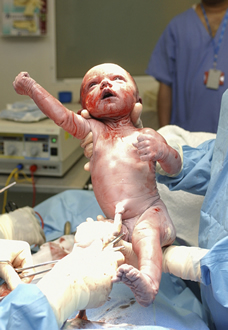In this article, you will find:
What to expect
The doctor will need your consent prior to doing a cesarean. He should tell you why the procedure is being proposed, and what its benefits and risks are. Ideally, you should have plenty of time to decide whether you want the surgery or not, although with an emergency cesarean, the time to think things over may be limited. Even so, you are always within your rights to say no to a cesarean, even if this means that your life or that of your baby is at risk.
Before the surgery, you will meet an anesthesiologist, who will make sure that you have no pain during your surgery and will help you with pain control afterward. Most women are awake during a cesarean. An injection of medication into the spinal fluid in your back, called a spinal block, numbs any sensation of pain (see Spinal block). Or, if you've been using an epidural for pain relief in labor (see Epidurals), this can be used for the surgery. After your anesthetic has been given, the anesthesiologist will check that it is working properly.
Being awake usually means that your birthing partner can stay with you and it's also a little safer for you and for your baby than a general anesthetic. Very occasionally a general anesthetic is needed (see General anesthesia).
Before the surgery, an IV line will be put in your hand or your arm so that fluids or medications can be given intraveneously if necessary. Also, the pubic hair on your belly may be shaved downward by about 1 in (3 cm) to clear the way for the cut. Both of these may be done before you go to the operation room or after you arrive there.
Once the anesthesiologist is assured you're pain free, a catheter will be inserted into your bladder and will stay in until the next day while your sensation recovers. Your abdomen will be cleaned with an antiseptic solution and sterile drapes will be placed over you, which prevent you and your partner from seeing the surgery.
During the surgery, a 4 in (10 cm) long cut will be made, usually horizontally, on the abdomen wall, across the bikini line, although occasionally an up-and-down cut below the belly button is done. Your bladder will be pushed down and the front of the uterus opened so that the doctor can access the baby. If your water hasn't already broken, this will be done now before the baby and placenta are delivered. The surgeon will release the baby's head from the pelvic brim and lift the baby out. Sometimes, another member of the team needs to put pressure on the uterus to assist this. You'll be able to see your baby when the cord has been cut, and once initial checkups have been done on your baby, either you or your partner should be able to hold him while the surgery is completed. After the umbilical cord is cut, your doctor will remove the placenta.
To finish the cesarean, the uterus will be closed up with one or two layers of stitches, then the abdomen wall will be stitched in separate layers. This takes about half an hour, although it can take longer, especially if you've had previous surgeries. You may have dissolvable stitches, or stitches that have to be taken out after four or five days; less commonly, small staples may be used. The choice is usually made by the doctor, but if you have a preference, make this known to the team caring for you before the surgery starts.

Your baby is gently lifted out of the uterus and the cord is clamped and cut.

You or your partner can enjoy the first hold of your baby while the surgical team completes the operation by delivering the placenta and stitching the incision.
